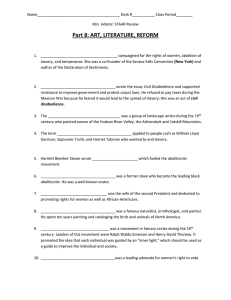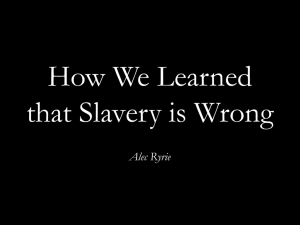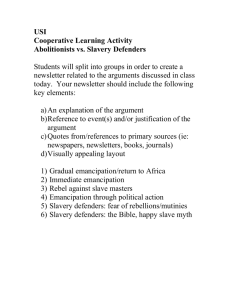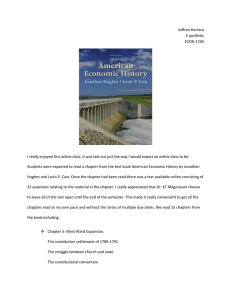Caribbean History From Colonialism to Independence AM217 David Lambert
advertisement
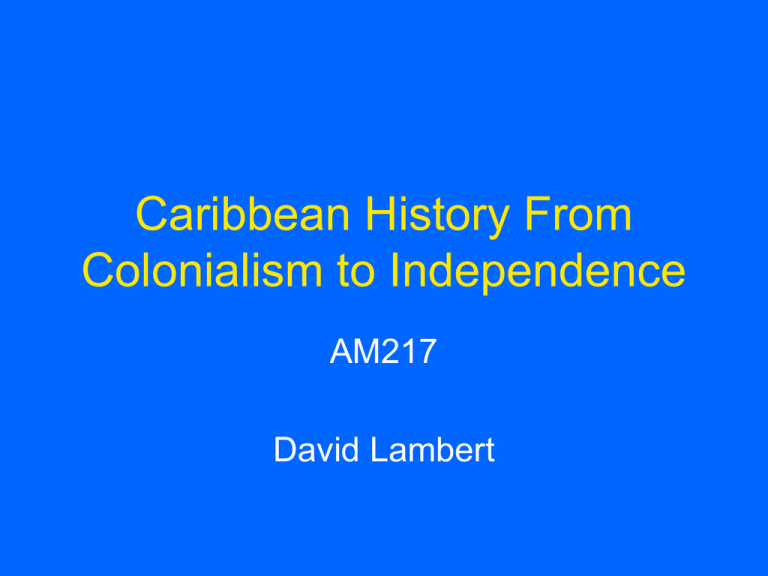
Caribbean History From Colonialism to Independence AM217 David Lambert Lecture: Abolishing slavery Tuesday 8th December, 11am-12pm Abolishing slavery 1. The problem of slavery i. Why was slavery abolished? 2. The British campaign to abolish slavery (c. 1780-1833) 3. Abolitionist views of enslaved people 4. Abolitionist disillusionment and resurgent racism 5. Other abolitions The problem of slavery In the 1760s there was nothing unprecedented about chattel slavery, even the slavery of one ethnic group to another. What was unprecedented by the 1760s and early 1770s was the emergence of a widespread conviction that New World slavery symbolized all the forces that threatened the true destiny of man [sic]. D. B. Davis, The problem of slavery in the age of revolution, 1975, p. 41. Power relations in age of abolition (c. 1780-1833) Political conflict Resistance Subjugation Slaveholders Slaves Abolitionists Power relations in age of abolition (c. 1780-1833) Political conflict Abolitionists Lobbying Resistance Subjugation Slaveholders Slaves Emancipation Metropolitan government Why was slavery abolished? • The British abolitionist movement emerged from the 1770s because of… – The evangelical revival, within and beyond the Anglican Church – The Enlightenment (a belief in progress) – The development of Romanticism (ideas of the ‘noble savage’) – The growth of free-tradism • In addition, British slavery was abolished because of… – Revolution in North America (independent from 1783), which meant that Britain lost half its slave colonies – Falling profits from the West Indian colonies – Intensified resistance from enslaved people The British abolitionist campaign • In 1787, the Society for the Abolition of the Slave Trade was formed. • The main campaigners were evangelicals, plus some former slaves. Olaudah Equiano’s Interesting narrative (1789) The British abolitionist campaign • In 1787, the Society for the Abolition of the Slave Trade was formed. • The main campaigners were evangelicals, plus some former slaves. • Initially focused on the slave trade (abolished 1807) and later slavery itself (abolished 1833-38). • Features of the campaign: – Extra-Parliamentary petitioning – Consumer boycott of West Indian sugar Consumer boycott of West Indian sugar Consumer boycott of West Indian sugar [W]ith every pound of sugar we may be considered as consuming two ounces of human flesh… William Fox, An Address to the People of Great Britain, on the Propriety of Abstaining from West India Sugar and Rum (1791) p. 2. The British abolitionist campaign • In 1787, the Society for the Abolition of the Slave Trade was formed. • The main campaigners were evangelicals and supporters of free-trade, plus some former slaves. • Initially focused on the slave trade (abolished 1807) and later slavery itself (abolished 1833-38). • Features of the campaign: – Extra-Parliamentary petitioning – Consumer boycott of West Indian sugar – Use of visual imagery Abolitionist visual imagery Seal of the Society for the Abolition of the Slave Trade. Made by Josiah Wedgwood, cameo in jasper, 1788. The British abolitionist campaign • In 1787, the Society for the Abolition of the Slave Trade was formed. • The main campaigners were evangelicals and supporters of free-trade, plus some former slaves. • Initially focused on the slave trade (abolished 1807) and later slavery itself (abolished 1833-38). • Features of the campaign: – Extra-Parliamentary petitioning – Consumer boycott of West Indian sugar – Use of visual imagery • These features make this the first modern political campaign. • The British campaign supported and encouraged those elsewhere. Abolitionist views of enslaved people Seal of the Society for the Abolition of the Slave Trade. Made by Josiah Wedgwood, cameo in jasper, 1788. Enslaved people as ‘commodities’ Abolitionist views of enslaved people Part of the discourse of the ‘good negro’: • Not quite equal • Christian (or soon to be converted) • Eternally grateful • Passive victim Emancipation: The abolition of slavery Expectations at emancipation • When slavery was ended, abolitionists and the metropolitan governments expected that the former slaves would become good Christians and grateful, hard-working labourers (the ‘good Negro’). • But when the ex-slaves did not conform to such expectations, abolitionists and others became disillusioned, setting the stage for the return of virulent racism. Resurgent racism after the abolition of slavery Exeter Hall, my philanthropic friends, has had its way in this matter…and, far over the sea, we have a few black persons rendered extremely ‘free’ indeed. Sitting yonder, with their beautiful muzzles up to the ears in pumpkins, imbibing sweet pulps and juices; the grinder and incisor teeth ready for every new work, and the pumpkins cheap as grass in those rich climates; while the sugar crops rot round them, uncut, because labour cannot be hired, so cheap are the pumpkins… Thomas Carlyle, Occasional Discourse on the Negro Question (1849) The paradox of abolitionism Abolitionism itself, no matter how well intended, was not the same as the victory over racism. The abolition of slavery was not the same as black emancipation. Abolitionism promoted new stereotypes of blacks – the movement humanized the image of blacks but also popularized the image of blacks as victims…The central icon of abolitionism…carried a clear message. It made emancipation conditional – on condition of conversion, on condition of docility and meekness, on condition of being on one’s knees. Jan Pieterse, White on black (1992), p. 60, emphasis added. Other abolitions: France • No mass antislavery movement for abolition • No reforms until 1830s. Most significant were those of 1845 that made self-purchase easier and prevented the flogging of women (‘Mackau laws’) • 1848 Revolution created Second Republic brought about political reform • Commission headed by Victor Schoelcher went to Caribbean to end slavery • Enslaved people pre-empted this and emancipation declared early in Martinique (23 May) and Guadeloupe (27 May) Other abolitions: Danish and Dutch • Danish Caribbean: – Steps toward abolition began in 1847 – Full emancipation planned for 1859 – Rebellion in St. Croix (July 1848) led to immediate emancipation across the Danish colonies • Dutch Caribbean: – Mainland Suriname the most important colony – Slavery ended 1863 following protests and reforms in 1850s – Full emancipation in 1873 came after ten-year apprenticeship



